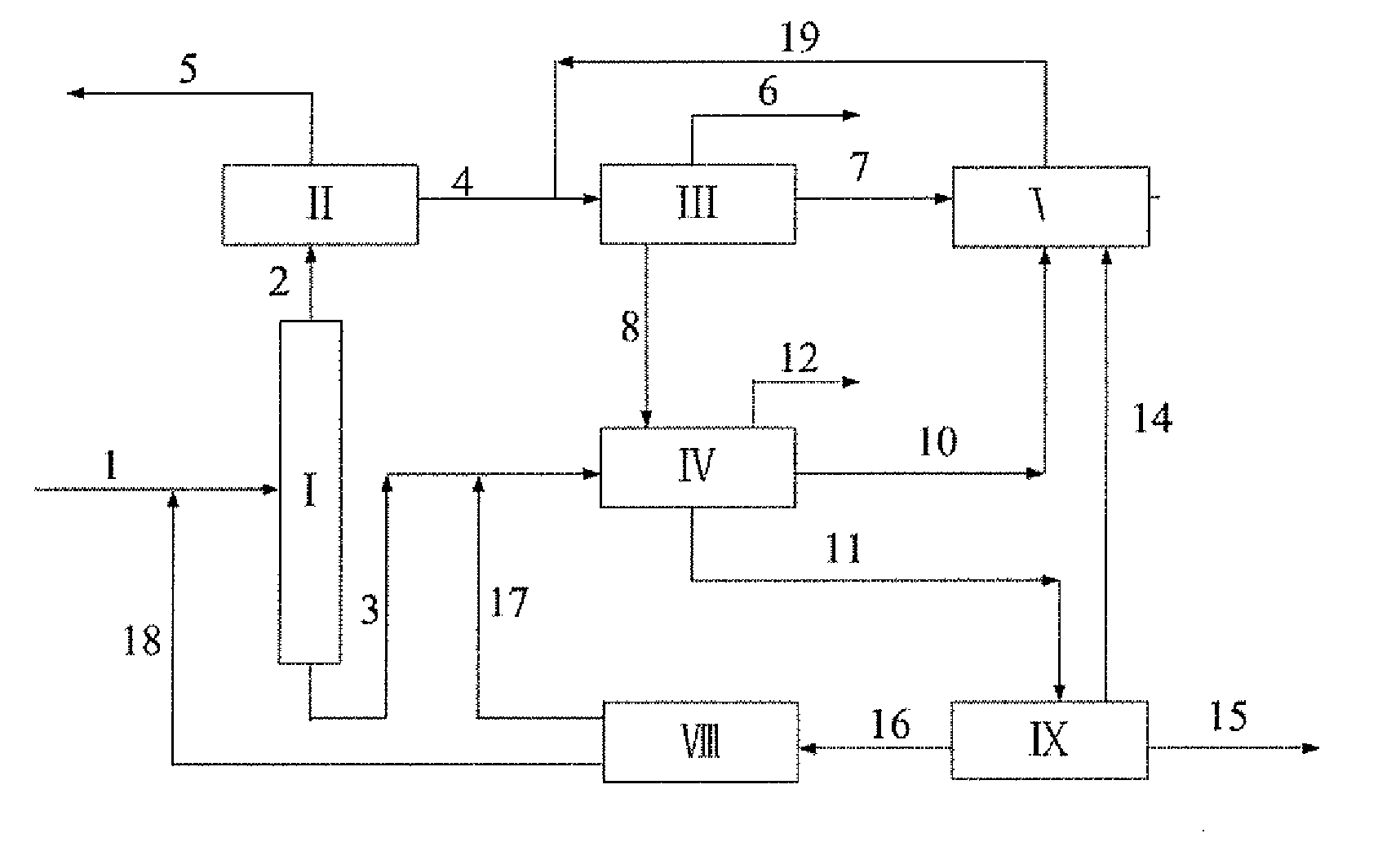Integrated Process for the Production of P-Xylene
a technology of p-xylene and integrated process, which is applied in the direction of physical/chemical process catalyst, sustainable manufacturing/processing, bulk chemical production, etc., can solve the problems of tatoray process having an obvious disadvantage, wasting aromatic hydrocarbon resources, and low yield of p-xylene, so as to increase the concentration of p-xylene, reduce the overall yield of p-xylene, and reduce the overall yield
- Summary
- Abstract
- Description
- Claims
- Application Information
AI Technical Summary
Benefits of technology
Problems solved by technology
Method used
Image
Examples
example 1
[0036]A C9+A feedstock was obtained by separating a feedstock from a petrochemical aromatic hydrocarbon united plant. The C9+A feedstock was subjected to dealkylation reaction in a fixed bed reactor in the presence of hydrogen. The reactor had an inner diameter of 25 mm and a length of 1000 mm, and was made of stainless steel. The reactor was packed with 20 g of a β-zeolite catalyst containing 0.05 wt % bismuth, which had been prepared by impregnating a powdery ammonium-form β-zeolite having a content of sodium oxide of 0.062 wt % and a molar ratio of silica to alumina of 30 with a 30 wt % aqueous solution of chemically pure bismuth nitrate, adding a 20 wt % aqueous solution of chemically pure nitric acid to the impregnated powder, sufficiently blending and homogenizing the mixture, extruding the mixture into strips, and calcining the extrudates at 550° C. for 4 hours to give the β-zeolite catalyst containing 0.05 wt % bismuth. Glass beads of φ3 mm were packed below and above the ca...
example 2
[0041]This experiment was performed by following the procedure as described in Example 1, except that the C8A obtained by separating the product of the toluene selective disproportionation reaction in an aromatic hydrocarbon fractionation unit was subjected to suspension crystallization separation. The suspension crystallizer had a volume of 500 L, was equipped with a jacket and a stirrer, and was made of stainless steel. The washing tower had a volume of 40 L, and was made of stainless steel. The feedstock was subjected to suspension crystallization in the crystallizer, and the slurry obtained after the crystallization was sent to the washing tower to perform solid-liquid separation and product purifying / washing.
[0042]The suspension crystallization separation process comprised a step of suspension crystallization and a step of washing / purifying. In the step of suspension crystallization, the feedstock was fed at a flow rate of 200 L / min and a temperature of 20° C., and the crystall...
example 3
[0043]A typical reformed depentanized oil containing C6A to C10+ hydrocarbons was used as a feedstock to investigate the capacities of the present process as shown in FIG. 2 for the production of p-xylene and benzene and the processing scales of various units therein. The composition of the reformed depentanized oil and the flow rates of various components used in this Example are listed in Table 5.
TABLE 5Composition of the reformed depentanized oiland flow rates of various componentsComponentsBenTolC8AC9AC10+ΣContent, wt %14.4126.7933.5324.021.25100.00Flow rate, Kg / hr12673235602948221122109587932Notation:C10+ represents hydrocarbons having 10 or more carbon atoms.
[0044]The experiment was carried out by using the flow rates of aromatic hydrocarbons (fresh feed) as listed in Table 5 according to the process as shown in FIG. 2. The conditions and catalyst used in dealkylation reaction of C9+A, the conditions and catalyst used in toluene selective disproportionation reaction, and the c...
PUM
| Property | Measurement | Unit |
|---|---|---|
| Temperature | aaaaa | aaaaa |
| Temperature | aaaaa | aaaaa |
| Temperature | aaaaa | aaaaa |
Abstract
Description
Claims
Application Information
 Login to View More
Login to View More - R&D
- Intellectual Property
- Life Sciences
- Materials
- Tech Scout
- Unparalleled Data Quality
- Higher Quality Content
- 60% Fewer Hallucinations
Browse by: Latest US Patents, China's latest patents, Technical Efficacy Thesaurus, Application Domain, Technology Topic, Popular Technical Reports.
© 2025 PatSnap. All rights reserved.Legal|Privacy policy|Modern Slavery Act Transparency Statement|Sitemap|About US| Contact US: help@patsnap.com



